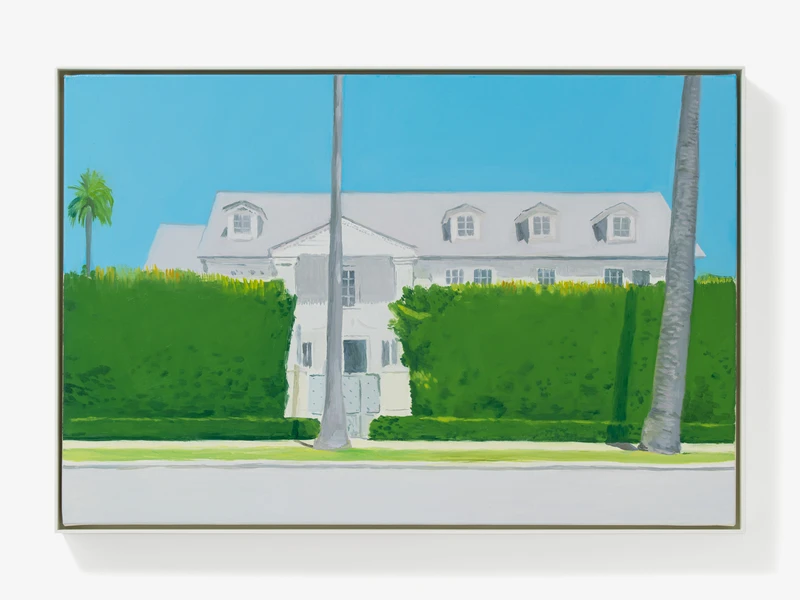Alessandro Raho
3 Feb-5 Mar 2022
PV 3 Feb 2022, 11am-7pm


Presented in the Upstairs Gallery and realised across the past two years, the show comprises previously unseen watercolours and oils depicting houses on the West Coast of America.
‘The house,’ writes Gaston Bachelard in The Poetics of Space (1958), ‘even more than the landscape, is a “psychic state”: ‘Even when reproduced as it appears from the outside, it bespeaks intimacy.’ But intimacy for – and at the expense of – whom? When a house is seen from a distance, it becomes a functioning metaphor for disconnect and partition. Windows are shut and doors bolted; walls hold firm and steady. If the house speaks of intimacy, it does so via the evocation of exclusion.
Alessandro Raho’s American houses are architectures of concealment. The paintings depict Californian dwellings that have been emptied of their inhabitants, treated with an unapologetic flatness and muted anonymity. Driveways are vacant, streets lacking footfall, windows as grey as asphalt. The titular building of House in Beverly Hills (2021), while the painting’s central focus, is all but obscured. If, as Bachelard proposed, windows are analogous to eyes, then Raho’s rebuff external attention. From our distant vantage point – behind a Yucca tree, across a well-tended lawn – we are permitted to view nothing but our own insufficiency.
Raho has drawn associations between this project and his childhood. Born in Nassau in 1971, Raho and his mother moved to England when he was two, while his father relocated to the US. And there is an irrefutable detachment within these works: a desire to familiarise oneself with the external so as to visualise that which lies within. But there is also a longing for the human details of life. Only when we empty things out do we realise what they can contain – and it is evident, in Raho’s scenes, what is missing. A home without life is a house. A window without movement, a form as grey as asphalt. It can feel as though Raho’s scenes are empty of air, but it is that his air is stagnant: untouched by the brilliance of life in space.
Raho is primarily known for meticulously rendered portraits of loved ones set against sterile backdrops. The disparity between these ‘faithful’ depictions and the nothingness that frames them is an entry point to Raho’s ongoing consideration of painting’s inborn inadequacy: the manner in which portraiture, specifically, can represent but never conjure. (As critic Michael Bracewell writes: ‘Raho’s subjects take their place as simultaneously intimate – their presence deeply felt – and as though withdrawn and withdrawing into a space and consciousness conveyed with visceral acuity by the processes of painting itself.’)
So, too, are Raho’s houses wary of their own relationship to ‘the real’. With their avenues unidentified and their facades scrubbed of life, these are less representations of familiar spaces than phantastic approximations of that familiarity. Not the thing itself but the memory of it; not the depicted location but a mimicry that suggests a connection. Which is not to say that painting is futile. Indeed, it is painting’s very ability to evoke this connection that is its unique skill. In French Riviera (2022), a bar of Le chocolat des Français chocolate is dressed in sun-kissed script and halftone magenta clouds. The work is at once a conventional exercise in still life and a suggestion of tenderness, nostalgia and the importance of imbuing the inanimate with animate life. Not the thing itself but the suggestion of it.
Raho’s first came to prominence when he was included in ‘Brilliant! New Art from London’, a seminal exhibition of ‘Young British Artists’ curated by Richard Flood at the Walker Art Center, Minneapolis, in 1995. Since then, Raho has exhibited in museums including Secession, Vienna, with Mark Leckey (2015); Drawing Room, London (2015); and De La Warr Pavilion, Bexhill-on-Sea (2014). In 2020, he was commissioned to produce a large outdoor work for the facade of the Southbank Centre, London (2020). Raho’s work has been acquired by museums worldwide, including National Portrait Gallery, London; The Berardo Collection, Sintra; Walker Art Center, Minneapolis and MoMA, New York.
Alessandro Raho press release
Download